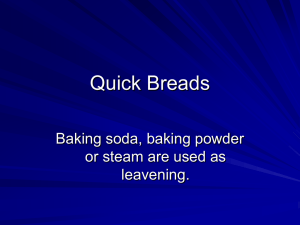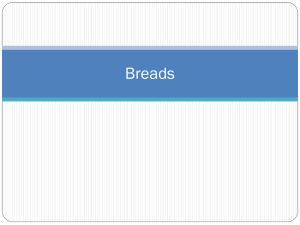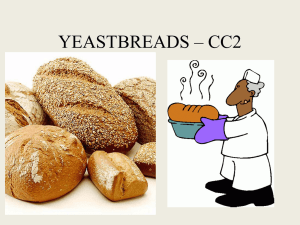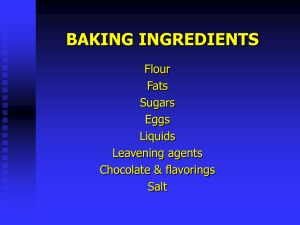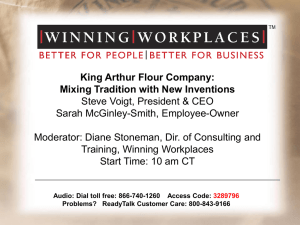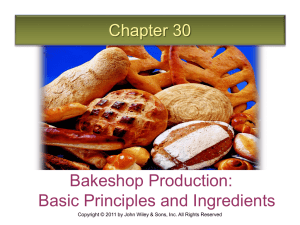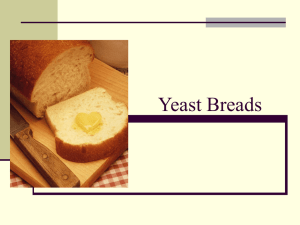Baking Chapter 21 - Riverdale High School
advertisement
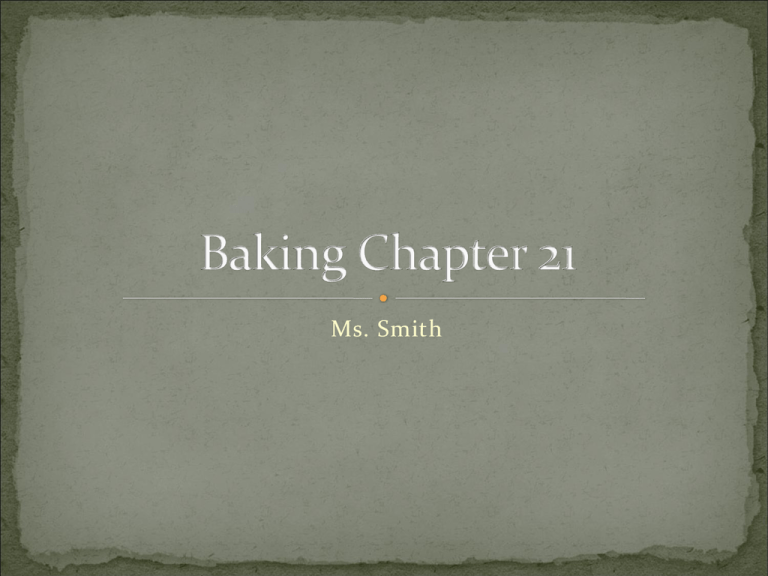
Ms. Smith 3.2 Assess the effect of nutrients on health, appearance and peak performance. 5.1 Examine the effects of various kitchen designs, tools, equipment and technology on food preparation. What are your favorite things to bake? What kind of ingredients do you use when baking them? Do you think that your baked goods are high in fat, sugar, and calories? Write a paragraph answering these questions explaining baked goods. Identify ingredients you have used in baking. All baked products are made from just a few basic ingredients. The different products result from differences in amounts of ingredients, the order in which the ingredients are combined, how they are mixed, and how they are baked. What are the differences in the appearance and textures of the products? Ingredients common to all baking: Flour, liquid, leavening agents, fat, sweeteners, eggs, and flavoring. Baked goods are generally nutritious, but many are high in fat, sugar, and calories. Flour is one ingredient found in nearly every baked product. The proteins and starch in flour make up most of a baked product’s structure. Gluten, a protein that affects the texture of a baked product, helps determine how the product will rise. All-purpose flour. The most popular flour in American kitchens. It gives good results for most products. Bread flour. Has the highest gluten content and gives the bread a strong structure. Cake flour. Contains less gluten and gives cakes a tender structure. Whole grain flours have weaker gluten than all- purpose flour. –Some have no gluten at all. This is why products made with only whole-grain flour rise less and have a heavy texture. Whole-grain flour include wheat, rye, and cornmeal. To overcome this limitation, whole-grain flours are generally combined with all-purpose flour in equal proportion in recipes. Whole-grain flours need to be stirred rather than sifted. –Particles are too large to go through a sifter. Why would some people bake with whole-grain flour? Liquids play a role in the many physical and chemical changes that occur during baking. Water and milk are the most common liquids used in baking. Milk adds flavor and nutrients, and helps baked goods brown better. To reduce fat in a recipe, use fat-free milk instead of whole milk. What is the difference between a cake that turns out flat and one that rises nicely? A substance that triggers a chemical action causing a baked product to rise, is called a leavening agent. Leaving agents make most baked products less compact and give them a softer texture. AIR is trapped in mixtures as they are beaten. – creaming fat and sugar, sifting flour, and adding beaten egg whites all add air to a baked good. When the mixture is heated, the trapped air expands and the product rises. (remember your fluffy waffles) STEAM leavens products that contain high amounts of water. As the product bakes, the water heats, which eventually turns into steam. It expands, causing the product to rise. (popovers and cream puffs) YEAST is a microorganism that produces carbon dioxide gas as it grows. It needs food (flour or sugar), liquid, and a warm temperature to grow. Different types of yeast: active dry yeast and quick-rising dry yeast come as dry granules in a packet. Quick-rising type leavens the dough about twice as quickly. Both can be stored at room temperature. Compressed yeast comes in an individually wrapped cakes and must be refrigerated. BAKING SODA is used whenever the recipe calls for buttermilk, yogurt, sour milk, or other acidic liquid. When combined with these types of liquids, baking soda produces carbon dioxide gas. This causes cookies, breads, or cakes to climb. (not flat) BAKING POWDER is made of baking soda and a powdered acid such as cream of tartar. Most common type, double-acting baking powder, releases some carbon dioxide gas when it is first mixed with a liquid. The remainder is released when it is heated. Fat adds richness, flavor, and tenderness. Fats can be solid or liquid. In place of butter or shortening, you can use regular margarine, but do not use soft, whipped, or liquid margarine spreads. (solid and liquid fats are not easily substituted for one another) Since fats play a major role in baked products, they usually can’t be eliminated. They can be reduced or partially substituted with other flavorful ingredients. Eggs add flavor, nutrients, richness, and color to baked products. They help form the structure of the baked product. When beaten, eggs ad air to the mixture. (fluffy) To reduce fat and cholesterol, use two egg whites or ¼ cup liquid egg substitute in place of one whole egg. Sugar is the most commonly used sweetener. It helps make baked products tender, adds sweetness and flavor, and helps the crust brown. Some sugar substitutes are suitable for baking, but others are not. Store most sweeteners in tightly covered containers in a cool place. Fruits, vegetables, and nuts add flavor, texture, and nutrients to baked goods. Herbs, spices, and extracts are used in small amounts to add flavor. Some sweet spices—for instance, cinnamon and nutmeg—can actually enhance the flavor enough to allow you to cut back slightly on sugar. When flour and liquid are mixed together, the gluten in flour develops, or becomes strong and elastic. When heated, the trapped gases expand and the product rises. The longer the mixing time, the greater the extent to which gluten is developed. Ex. Ingredients for cakes and quick breads are mixed only long enough to combine them. (gluten not strong) (waffle mix) Yeast breads, on the other hand, are mixed much longer than cakes. (worked with hands) The amount of liquid in relation to the amount of flour determines whether a mixture is a batter or a dough. Batters have more liquids than doughs. POUR BATTERS are thin enough to pour in a steady stream. (cakes, pancakes, and waffles) DROP BATTERS are thick and are usually spooned into pans. (quick breads and cookies) SOFT DOUGHS are soft and sticky but can be touched and handled. (rolled biscuits, yeast breads and rolls, and some cookies start with soft doughs) STIFF DOUGHS are firm to the touch. Easy to work with and cut, they form the basis for piecrust and some cookies. KNEAD-work the dough with your hands to thoroughly mix ingredients and develop gluten. 1.) turn the dough out on a very lightly floured surface. 2.) with the heel of your hands, push down on the edge of the dough nearest you. 3.) fold the dough in half toward you and give it a quarter turn. 4.) continue pushing, folding, and turning for the time directed in the recipe. http://www.bettycrocker.com/videos/videolibrary/tec hnique/kneading-dough Baking pans you choose can affect the results of baking. Use the size and type of pan specified in the recipe. If the pan is too small, the product will not bake properly. The material the pan is made of is also important. Most recipes are developed for light- colored metal pans. If you use glass pans, lower the temperature by 25 degree F. Glass retains more heat than metal. Baking pans must be properly prepared so that products can be easily removed from them at the end of baking. Methods for preparing pans: GREASE AND FLOUR: lightly grease a pan with fat and dust it with flour. Use waxed paper to spread the fat. Sprinkle all-purpose flour into the pan. Tilt the pan to different angles until the flour is spread evenly. Turn the pan upside down over the sink, and tap it gently to remove excess flour. SPRAY WITH A VEGETABLE-OIL COOKING SPRAY. This is the easiest method, but it may not work with all products. Follow the directions on the label or in your recipe. LINE A PAN WITH PAPER. Start by cutting a piece of cooking parchment the same shape and size as the pan bottom. Grease the pan and line the bottom with parchment paper. When the product is removed, peel the paper off the bottom. This method is used for rich cakes, such as fruitcakes. In a conventional oven, the dry heat creates desirable changes. Product browns, and depending on ingredients, a crispy crust may develop. Baked products do not brown or develop a crust in microwave because it cooks with moist heat. (sticky buns) Preheat oven, and before turning on oven make sure that racks are in proper position. Begin checking for product doneness about 5 minutes before time is up. Some baked products must be removed immediately when they come out of the oven. Others need to cool for a few minutes in the pan. Use cooling racks so that baked goods will cool faster and stay crisp. When baked goods are allowed to cool on a solid surface, such as a cutting board, moisture collects and the product can become soggy. Perishable baked products, including those with cream fillings or frostings, have to be refrigerated. Studies show that other baked products get stale quickly when stored at refrigerator temperatures. Store them at room temperature if they will be eaten within 3 days. To store them longer, freeze them in airtight freezer containers. Nutrients in Quick Breads Quick breads can be a tasty way of getting some of the nutrients your body needs. Good sources of carbohydrates, protein, B vitamins, and iron. Using whole grains adds fiber and trace minerals. Adding fruits, vegetables, and nuts packs in even more vitamins and minerals– as well as flavor and texture. Muffins are prepared using the muffin method. The MOST IMPORTANT part of this procedure is properly mixing the liquid and dry ingredients. Muffins that are properly mixed have a rounded, pebbly top with a coarse but tender texture inside. 1.) SIFT (to remove large lumps and pieces) together or mix all dry ingredients (flour, sugar, baking powder, spices) in a large bowl. Using the back of a spoon, make a well in the center of the dry ingredients. 2.) BEAT all liquid ingredients (eggs, milk or water, oil or melted fat, liquid flavorings) together in a small bowl until they are well blended. 3.) POUR the liquid into the well you have made in the dry ingredients. A few floury spots can remain, and the batter should be lumpy. 4.) FOLD in ingredients such as chopped nuts and raisins gently. http://www.answerstv.com/AnswersTV/Channel.aspx? ChannelID=523dcd4b-12bc-4ad9-a1d564b59bf3b4fe&StartPoint=Folder1090&PlayItem=5318 &AP=true Flavors of muffins can easily be varied with different ingredients. Fresh and dried fruits are often included. (cranberries, blueberries, chopped dates, dried apricots, or your favor combinations) Muffin recipes may often include yogurt, tofu, shredded raw vegetables (zucchini or carrots), or cooked vegetables (such as sweet potatoes and winter squash). Instead of greasing muffin pans, you can line them with paper baking cups. (as seen in video) Fill the cups only two-thirds full. If you add more than that, batter will overflow and the muffins will have odd shapes. They are done when they are nicely browned. A wooden pick inserted in the center should come out clean. Muffins are best served warm. Many quick loaf breads are mixed in the same manner as muffins. Some loaf breads are flavored with vegetables and herbs. Quick breads are generally baked in greased loaf pans. Don’t be surprised if the top f the loaf cracks, this is typical for quick breads. Biscuits are delicate, small breads. Properly made, they have a tender but crisp crust and are an even, light brown color. The inside is slightly moist and creamy whit, and peels apart in tender layers. 2 kinds of biscuits: ROLLED and DROPPED. Both are made using the PASTRY and BISCUIT METHOD of mixing. In the pastry and biscuit method, the fat is cut into the flour. To CUT IN means to mix solid fat and flour using a pastry blender or two knives and a cutting motion. This technique leaves the fat in fine particles in the dough. During baking, the fat melts between layers of flour, giving a flaky texture. 1.) Sift together or mix the dry ingredients in a large bowl. 2.) Cut the shortening into the flour until the particles are the size of peas or coarse bread crumbs. 3.) Make a well in the center of the dry ingredients, as in the muffin method, and add the liquids. Stir just until the ingredients are blended and form a soft dough. --Once you have mixed the dough, you can proceed with your recipe for either ROLLED or DROP biscuits. ROLLED BISCUITS are made by rolling out dough to an even thickness and cutting it with a biscuit cutter. (rim of water glass) Begin by turning the dough out on a lightly floured board and kneading about ten strokes. Knead as much as possible with the tips of your fingers, since warmth from your hands may melt the shortening, causing biscuits to be tough. Overkneading results in tough, compact biscuits. Next, roll the dough out to a uniform thickness of about ½ inch. Cut the biscuits out with a biscuit cutter that is lightly dusted with flour. Pres the cutter straight down so that the biscuits have straight sides and even shapes. (do not twist the cutter, dough might tear) Reroll any leftover dough to make more biscuits. Place biscuits on an ungreased baking sheet, about 1 inch apart. Bake according to recipe directions. DROP BISCUITS are made by dropping dough from a spoon. (because they contain more liquid than rolled) Ever had Red Lobster biscuits? They are just as flavorful and flaky as rolled biscuits. Mix the batter for drop biscuits using the same method as for rolled biscuits. Drop the batter in mounds on a greased cookie sheet about 1 inch apart. Bake according to recipe directions. Biscuits are delicious when they are eaten warm, right out of the oven. Serve them with meals, or use them for sandwiches. For variety, they can be topped with gravy or sweet fruit or cream. Biscuits can be made ahead of time, frozen, and then reheated in the microwave. Many people believe that bread baking is too time- consuming to fit in with today’s fast-paced lifestyles. Making yeast dough is a flexible process and can be timed to fit into your schedule. Several appliances can help speed up the bread making process. A microwave can be used to heat the liquid before adding it to the yeast, to bring refrigerated ingredients to room temperature, and to let the dough rise. Check owner’s manual for specific directions, which will vary depending on the oven’s power and controls. A heavy-duty mixer with a dough hook or a powerful food processor can be used to mix yeast dough quickly. These appliances will knead it in about 6 minutes compared with the 8 or 10 minutes required to knead it by hand. Yeast bread and rolls are both made by using the same simple five-step procedure. The steps include mixing the dough, kneading it, letting it rise, shaping it, and, finally baking it. Most yeast breads are a simple mixture of flour, salt, sugar, liquid, fat, and yeast. Sugar provides food for the yeast so that it will grow. Salt controls the action of the yeast. Recipes for homemade bread call for all-purpose flour. (makes loaf with good texture, and more readily available than bread flour) Yeast will not grow if the liquid is too cold and will die if the liquid is too hot. Make sure the ingredients are at room temperature and the liquid is heated to the right temperature. When yeast is added to liquid at the proper temp, the mixture becomes cloudy and begins to form a foamy layer within minutes. The QUICK-MIX METHOD is a bread-making method that combines active dry yeast with the dry ingredients. A standard mixer will work for the first part of the mixing until the dough thickens and becomes too heavy for it. Beat the rest of the flour in with a wooden spoon. 1.) Combine party of the flour with the un-disolved active dry yeast, sugar, and salt in a large bowl. 2.) Heat the liquid and fat to between 120 F and 130 F. 3.) Add the liquid and dry ingredients, beating them with a mixer until they are well blended. At this point, the gluten is beginning to develop. 4.) Beat in enough of the remaining flour to make the kind of dough specified in the recipe. You may need more or less flour than the recipe calls for. Some kinds absorb more liquid than others. Turn the dough out on a lightly floured surface. Knead the dough until it becomes a smooth, shiny ball, about 8 to 10 minutes. Use just enough flour to keep the dough from sticking to the work surface or to your hands. Too much flour will give a tough texture. Don’t be concerned if bubbles develop, they are a clue that the gluten is developing. Shape the dough into a ball, and place it in a well-oiled bowl. Turn the ball in the bowl so that all sides are coated with oil. Place a piece of plastic wrap over the top of the dough to keep it from drying out; then cover the bowl with a clean dish towel. Set the bowl in a warm, draft-free place for about 1 to 1 ½ hours. The dough should rise to double the original size. (bread dough made with whole-grain flour will take longer to rise) Once it has risen, punch the dough down by gently pressing your fist into the center. Gently pull the dough from the sides of the bowl toward the middle. These actions will eliminate the largest air bubbles. When the ball has doubled in size, the dough is ready for the fourth stage—shaping. To determine if dough is ready, push two fingers gently into the surface, and if the finger indentations remain, the dough is ready to shape. Shape the dough into loaves or rolls, according to recipe directions. Use kitchen scissors or a sharp knife to cut the dough into pieces. Don’t pull it apart. Place it in a greased pan or on a baking sheet. Cover and let he shaped dough rise again until it doubles in size. Bread and rolls have a nicely browned crust when done baking. Check loaves for doneness by tapping them with your finger. If they sound hollow, they are done. Remove the bread or rolls from the pans, and place them immediately on a wire cooling rack. The rack prevents moisture from forming on the bottom crust and making it soggy. Let loaves stand about 20 minutes for easier cutting. http://www.youtube.com/watch?v=ZnA3i1MyB-k
